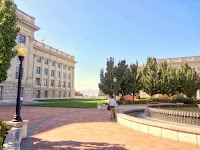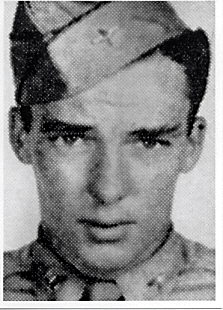When I was at the Salt Lake City 1983 flood, a hydrologist took me to the top of the mountain shown in these photos. From there, I was able to see the phenomenal view of large sections of the a major American city under water. These floodwater's caused major chemical waste ponds to overflow and their effluents downstream, in addition to all the other problems that result from a flood. It was dangerous.




 Yet in 2013 I stood on the same mountain just behind the Utah State Capital that overlooks much of the city and all I saw were gleaming new buildings and dry land. It was as if the flood never happened.
Yet in 2013 I stood on the same mountain just behind the Utah State Capital that overlooks much of the city and all I saw were gleaming new buildings and dry land. It was as if the flood never happened.Behind me million dollar houses with wrap around porches were being built. Before me the downtown is beginning to look like Manhattan with local, regional, national and international banks competing for who could build the tallest skyscraper.
 LDS missionaries go to exotic and remote locations and learn obscure languages. As a result, they are heavily represented in our intelligence services, especially the CIA and military branch intelligence units.
LDS missionaries go to exotic and remote locations and learn obscure languages. As a result, they are heavily represented in our intelligence services, especially the CIA and military branch intelligence units.This should give them an advantage in identifying jihadi threats and attacks, but not necessarily. One of the talks I heard at the TACDA conference was about the danger of expecting the normal to always be normal that all humans have. Unfortunately, it causes us to ignore obvious dangers and threats when they are right in front of us.
 The speaker used the example of two USAF Academy cadets being stuck in snow in a remote area and heating their car continuously where heating it for ten minutes every hour would have stretched their gas to the point where they could have survived.
The speaker used the example of two USAF Academy cadets being stuck in snow in a remote area and heating their car continuously where heating it for ten minutes every hour would have stretched their gas to the point where they could have survived. Another example was three pilots who ignored obvious signs their large commercial airline was in a stall even though the signs were before them.
Another example was three pilots who ignored obvious signs their large commercial airline was in a stall even though the signs were before them. I have another example I saw in Salt Lake City.
I have another example I saw in Salt Lake City. When I toured the magnificent solid granite state capital, I saw no security. No one checked my backpack when I entered. No one looked me over. I saw no physical security guarding that building.
When I toured the magnificent solid granite state capital, I saw no security. No one checked my backpack when I entered. No one looked me over. I saw no physical security guarding that building.When I asked about this later, I was told that Utah is a carry state and that anyone threatening the legislators would be answered by armed legislators. That's funny, but it is not a security plan.



 Granted, I'm an outsider and not privy to the Utah State Capital security group, but just like a thief will pass a house where he hears a dog or sees security cameras, so too jihadi's often pass a hardened target for a softer and more vulnerable one.
Granted, I'm an outsider and not privy to the Utah State Capital security group, but just like a thief will pass a house where he hears a dog or sees security cameras, so too jihadi's often pass a hardened target for a softer and more vulnerable one.It would be worth the time of Utah's state capital security forces to make a show of force at all entrances to the building, even when they are not in session as when I visited.

Predictive Intelligence
This is doubly troubling because the first jihadi mass murder mall attack was in Trolley Square in Salt Lake City in 2004...not in Kenya in 2013. Here is a link to the story.And here is a summary of the attack:
"On the evening of Feb. 12, 2007, a young Muslim man walked into the Trolley Square mall in Salt Lake City with a pistol-grip, 12-gauge shotgun and a 38-caliber revolver and opened fire on shoppers, killing five and wounding four others, including a pregnant woman.



 Police say he “sought to kill as many people as possible.” He had a backpack full of ammunition, enough firepower to massacre dozens of innocent people. But fortunately, an off-duty cop returned fire and eventually, with the help of other police, put an end to the terrorist’s life and grand plans." Apparently, Talovic had prepared for his own martyrdom. He told a friend before the attack that “tomorrow is going to be the happiest day of my life, but it will happen only once.”“One interpretation of this statement is that Talovic was happy that he was going to be a shahid — that he would be committing jihad and go to paradise,” according to a July 2, 2007, electronic communication from the Salt Lake City field office to the counterterrorism division of the FBI.Before leaving for the mall, which was located just a few minutes from the mosque he attended, he showered and put on a necklace featuring a miniature Koran, a gift from his father. Prior to his death, some witnesses overheard Talovic shouting “Allahu Akbar!” — or “Allah is greatest!” — a ritual cry of suicide terrorists.
Police say he “sought to kill as many people as possible.” He had a backpack full of ammunition, enough firepower to massacre dozens of innocent people. But fortunately, an off-duty cop returned fire and eventually, with the help of other police, put an end to the terrorist’s life and grand plans." Apparently, Talovic had prepared for his own martyrdom. He told a friend before the attack that “tomorrow is going to be the happiest day of my life, but it will happen only once.”“One interpretation of this statement is that Talovic was happy that he was going to be a shahid — that he would be committing jihad and go to paradise,” according to a July 2, 2007, electronic communication from the Salt Lake City field office to the counterterrorism division of the FBI.Before leaving for the mall, which was located just a few minutes from the mosque he attended, he showered and put on a necklace featuring a miniature Koran, a gift from his father. Prior to his death, some witnesses overheard Talovic shouting “Allahu Akbar!” — or “Allah is greatest!” — a ritual cry of suicide terrorists.Talovic was “described as religious,” according to the FBI communique, marked “Secret.” “He had attend the mosque regularly for Friday
That mosque was the Al-Noor Mosque, led by a Somali national. Some investigators suspect Talovic was radicalized there.

 These details are buried in the more than 745 pages of investigative reports generated in the case by the FBI, the same agency that officially claims it found no evidence Talovic’s religion was a factor.
These details are buried in the more than 745 pages of investigative reports generated in the case by the FBI, the same agency that officially claims it found no evidence Talovic’s religion was a factor.“Clearly, he had some religious beliefs,” Fuhrman said, “but just because someone has religious beliefs doesn’t mean anything is a terrorist act.”
That last line is frightening, because it is the same line used by the media and and others to pretend jihadi attacks are always something else...workplace violence is the cover story for Major Hassan, and there are many other subterfuges.The most common media excuse is that the terrorist had "mental issues." Yeah. No kidding.
My observation is the visible lack of security in the State Capital building along with the local unwillingness to address the jihadi's living among them is fraught with danger for the citizens of Salt Lake City.
 Disasters are man-made and natural. They did an outstanding job of handling and even prospering from the 1983 flood. Not sure they are aware of how vulnerable they are to another Talovic attack, especially if it is many Talovic's attacking.
Disasters are man-made and natural. They did an outstanding job of handling and even prospering from the 1983 flood. Not sure they are aware of how vulnerable they are to another Talovic attack, especially if it is many Talovic's attacking.
 Salt Lake City is such a stunningly beautiful city. From what I saw, it is also a very open city. It is an unfortunate fact of life that jihadi's are looking for soft targets in the U.S. As they say on so many of their websites, "We have been at war with you for 1,400 years. You forgot. We did not."
Salt Lake City is such a stunningly beautiful city. From what I saw, it is also a very open city. It is an unfortunate fact of life that jihadi's are looking for soft targets in the U.S. As they say on so many of their websites, "We have been at war with you for 1,400 years. You forgot. We did not."I pray that those responsible for the safety and security of the Americans in Salt Lake City do what they must before another jihadi attack.
As these photos demonstrate, it is a beautiful, beautiful city. And the people are even more so.

 May they receive the predictive intelligence, preemptive identification, and early shut down of the threats they face, like all Americans, from people who have made no secret of their intentions.
May they receive the predictive intelligence, preemptive identification, and early shut down of the threats they face, like all Americans, from people who have made no secret of their intentions.









Is Salt Lake City a Dry City
My wife kept insisting before I flew there that Salt Lake City was a dry city in the sense of not allowing alcohol sales.
 That may have been true in 1983. I only remember the Marriott's hotels having bars and serving alcohol then.
That may have been true in 1983. I only remember the Marriott's hotels having bars and serving alcohol then.That is no longer the case.
In fact, Salt Lake City, like so much of the Pacific Northwest, has a thriving craft beer industry.
The photo here of the Salt Lake Brewing Company is a place that carries a tremendous number of craft brews.






















